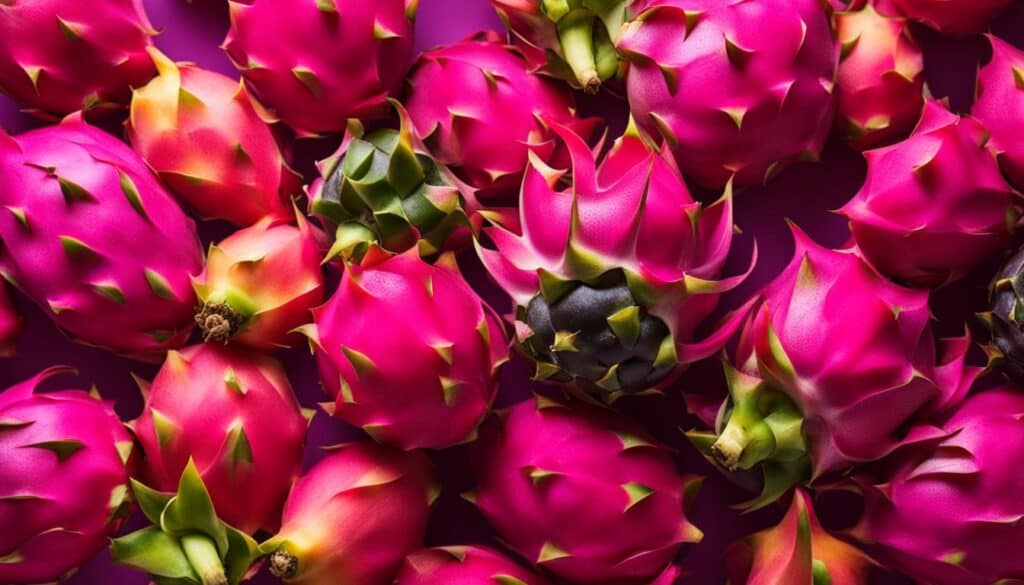After consuming dragon fruit myself, I noticed a change in the color of my urine. It had a pinkish red hue, which initially alarmed me. However, after conducting some research and consulting with healthcare professionals, I learned that this discoloration is not harmful and is a known side effect of consuming dragon fruit.
Dragon fruit contains a pigment called betahiasin, which gives the fruit its vibrant red color. This pigment is not fully metabolized by the body and is excreted through urine, causing the temporary change in color. It’s important to note that this is similar to the effect of other foods, such as asparagus, which can also cause changes in urine color.
If you consume dragon fruit and notice a change in urine color, there’s no need to worry. It is a harmless and natural reaction. However, if the color change occurs without any known triggers or persists beyond the consumption of dragon fruit, it is advisable to consult a healthcare professional for further guidance.
Key Takeaways
- Consuming dragon fruit can result in a temporary change in urine color, specifically a pinkish red hue.
- The pigments present in dragon fruit, such as betahiasin, are not fully metabolized by the body and are excreted through urine.
- Similar to other foods, such as asparagus, dragon fruit can cause changes in urine color, but it is not harmful.
- If the urine color change occurs without any known triggers or persists beyond dragon fruit consumption, consulting a healthcare professional is advisable.
Consuming dragon fruit may occasionally lead to reddish or pinkish urine, which is typically harmless and attributed to the natural pigments in the fruit, but if you experience persistent or concerning symptoms, consult a healthcare professional.
Dragon Fruit Nutrition and Health Benefits
Dragon fruit, also known as pitaya, is a highly nutritious tropical fruit that offers a wide range of health benefits. Bursting with essential vitamins and minerals, this exotic fruit is a delightful addition to any diet.
One of the key health benefits of dragon fruit is its high vitamin C content. In fact, a single serving of dragon fruit provides more than 100% of the recommended daily intake of vitamin C. This important nutrient plays a vital role in supporting the immune system and promoting overall health and well-being.
In addition to vitamin C, dragon fruit is loaded with antioxidants, which help protect the body against harmful free radicals. These antioxidants contribute to reducing oxidative stress and inflammation, and may even have anti-aging properties.
Furthermore, dragon fruit is a low-calorie and low-fat fruit, making it an excellent choice for those watching their weight. It is also a good source of dietary fiber, which aids in digestion and helps maintain a healthy digestive system.
The potential health benefits of dragon fruit extend beyond its nutritional profile. Research suggests that dragon fruit possesses anti-inflammatory properties, which may help reduce inflammation in the body and support overall well-being.
Overall, the combination of essential vitamins, minerals, antioxidants, and fiber make dragon fruit a powerhouse of nutrition that can contribute to a healthy and balanced diet.
Dragon Fruit Nutritional Profile
To better understand the nutritional value of dragon fruit, let’s take a closer look at its key components:
| Nutrient | Amount per 100g |
|---|---|
| Calories | 60 |
| Protein | 1.2g |
| Fat | 0.4g |
| Carbohydrates | 13g |
| Dietary Fiber | 1.7g |
| Vitamin C | 20.5mg |
| Vitamin E | 0.15mg |
| Potassium | 183.5mg |
| Calcium | 8.8mg |
How to Enjoy Dragon Fruit
Dragon fruit can be enjoyed in various ways, allowing you to savor its unique flavor and reap its health benefits. Here are a few suggestions:
- Slice the dragon fruit in half and scoop out the flesh with a spoon for a simple and refreshing snack.
- Add dragon fruit to smoothies or fruit bowls for a burst of vibrant color and natural sweetness.
- Use dragon fruit as a topping for salads or yogurt bowls for an exotic twist.
- Incorporate dragon fruit into desserts, such as sorbets or fruit tarts, to create visually appealing and delicious treats.
Experiment with different recipes and get creative with your dragon fruit creations to enjoy its unique taste and health benefits.
Dragon Fruit and Urinary Changes
The consumption of dragon fruit can result in temporary changes in urine color, specifically a pinkish red hue. These changes are attributed to the presence of the betahiasin pigment in the fruit, which acts as a natural food coloring.
This phenomenon, known as pseudohematuria, causes the urine to appear false red or pink. Rest assured, this condition is harmless and will naturally resolve once the consumption of dragon fruit is discontinued.
If you notice any changes in urine color after consuming dragon fruit, there’s no need to be alarmed. However, if the color change persists without any known triggers or if you have any concerns, it is advisable to consult a healthcare professional for a proper evaluation.
Other Foods That Can Affect Urine Color
Besides dragon fruit, there are other foods that can also impact the color of urine. Asparagus consumption, for example, can cause the urine to appear greenish due to the presence of asparagusic acid compounds. Similarly, consuming a significant amount of salmon, which is rich in vitamin B6, may result in yellowish urine with a distinct smell. These changes in urine color are generally harmless and will subside once the triggering foods are no longer consumed. It is crucial to differentiate between normal food-related color changes and any abnormal or persistent alterations in urine color, which should be addressed by a healthcare professional.
To illustrate the impact of different foods on urine color, consider the following:
| Foods | Urine Color |
|---|---|
| Dragon Fruit | Pinkish red |
| Asparagus | Greenish |
| Salmon | Yellowish |
Asparagus is known to have a distinct effect on urine color, often turning it green. This is due to asparagusic acid, a compound found in asparagus, which is metabolized by the body and excreted through urine. Similarly, consuming a significant amount of salmon, which is high in vitamin B6, may result in urine that is yellowish with a unique smell. These color changes are generally harmless and temporary, fading once the foods are no longer consumed.
Understanding Urine Color and Its Potential Significance
Urine color can vary for various reasons, such as hydration levels, diet, medication, and certain health conditions. While changes in urine color after consuming dragon fruit are generally temporary and harmless, it’s important to be aware of potential causes of red or pink urine that may require medical attention.
Some potential causes of red urine include:
- Blood in the urine (hematuria)
- Urinary tract infections
- Kidney stones
- Certain medications
It’s essential to differentiate between natural food-related color changes and other potential underlying factors. If you have any doubts or concerns regarding the color of your urine, it’s advisable to consult a healthcare professional for an accurate diagnosis and appropriate management.
| Potential Causes of Red Urine | Symptoms |
|---|---|
| Blood in the urine (hematuria) | Red or pink urine that is not related to food consumption, presence of blood clots in urine, frequent urination |
| Urinary tract infections | Red or pink urine accompanied by a burning sensation during urination, pain in the lower abdomen |
| Kidney stones | Red or pink urine, severe pain in the sides, back, or lower abdomen, frequent urge to urinate |
| Certain medications | Red or pink urine as a side effect of specific medications prescribed by a healthcare professional |
When to Seek Medical Attention?
If you experience red or pink urine that is not related to food consumption, lasts beyond a few days, is accompanied by additional symptoms such as pain, discomfort, or changes in urination patterns, it’s crucial to consult a healthcare professional for further evaluation.
Remember, while changes in urine color after consuming dragon fruit are generally harmless, it’s always better to err on the side of caution and seek professional guidance when in doubt about your health.
It is important to differentiate between natural food-related color changes and other potential underlying factors that may affect the color of urine. If you have any doubts or concerns regarding the color of your urine, it’s advisable to consult a healthcare professional for an accurate diagnosis and appropriate management.
Recognizing the Safety of Dragon Fruit Consumption
When it comes to the safety of consuming dragon fruit, rest assured that it is generally considered safe and well-tolerated by most individuals. However, it’s important to be aware that individual reactions may vary.
Some people may experience mild gastrointestinal discomfort, such as bloating or diarrhea, after consuming dragon fruit. These symptoms are usually temporary and tend to subside on their own.
To ensure a positive experience, it is advisable to start with small amounts of dragon fruit and gradually increase your intake. This allows you to assess your personal tolerance and identify any potential adverse reactions.
If you experience any persistent or severe adverse reactions after consuming dragon fruit, it is recommended to discontinue consumption and seek medical advice if necessary.
Dragon fruit is a tropical fruit that offers a range of health benefits, but like any food, it’s important to be mindful of your individual response to ensure your well-being.
Incorporating Dragon Fruit into a Healthy Diet
Dragon fruit is not only a nutritious choice but also a tasty addition to a well-balanced diet. With its vibrant pink or white flesh and unique texture, this exotic fruit can be enjoyed in various ways, adding a touch of exotic flavor to your meals. Here are some ideas to help you incorporate dragon fruit into your daily diet:
- Enjoy it fresh: Simply slice the dragon fruit in half and scoop out the flesh with a spoon. Eat it as is for a refreshing and healthy snack.
- Add it to smoothies: Blend dragon fruit chunks with your favorite fruits, yogurt, or plant-based milk for a nutritious and colorful smoothie.
- Use it in salads: Cut the dragon fruit into cubes or slices and toss it into your salads for an exotic twist. Its mild sweetness pairs well with leafy greens and other fruits.
- Create dragon fruit-based desserts: From dragon fruit sorbet to dragon fruit parfaits, there are plenty of dessert options that showcase the unique flavor and vibrant color of this fruit.
Incorporating dragon fruit into your diet can diversify your nutrient intake and contribute to overall health. Its natural sweetness and eye-catching appearance make it a delightful addition to any meal or snack. Get creative and experiment with different recipes to fully enjoy the benefits of this exotic fruit.

Exploring the Exotic Appeal of Dragon Fruit
Dragon fruit, with its eye-catching appearance and exotic appeal, has become a popular fruit worldwide. Primarily grown in tropical regions, this fruit comes in various varieties, each with its own unique characteristics. From its vibrant colors to its mesmerizing scale-like patterns, dragon fruit is a feast for the eyes.
The fruit’s exterior can range from deep pink and vibrant red to bright yellow, captivating anyone who lays eyes on it. The flesh of dragon fruit is equally fascinating, with two main color variations. The white-fleshed variety showcases a beautiful contrast against the fruit’s vibrant exterior, while the red-fleshed variety adds a striking burst of color. Both variations offer a mildly sweet and refreshing flavor.
The versatility of dragon fruit extends beyond its appearance. This exotic gem is not only visually appealing but is also packed with numerous health benefits. With its distinct flavors and high nutritional value, dragon fruit has made its mark in culinary applications around the world. Whether enjoyed fresh, incorporated into smoothies, or used in creative desserts, it adds a touch of exoticism to any dish.

Varieties of Dragon Fruit:
- Red-fleshed varieties
- White-fleshed varieties
Dragon Fruit Appearance:
- Vibrant colors: pink, red, yellow
- Scale-like patterns on the exterior
From its captivating appearance to its delicious taste and numerous health benefits, dragon fruit has become an icon of tropical fruit. It’s no wonder that dragon fruit has gained popularity worldwide, with its distinct and alluring characteristics.
Embracing the Rich Cultural Significance of Dragon Fruit
Dragon fruit holds a significant place in the cultures of various countries, where it is often associated with concepts such as good luck, prosperity, and fertility. In many Asian cultures, it is regarded as a symbol of wealth and abundance, believed to bring positive energy and fortune to those who consume it.
The cultural significance of dragon fruit extends beyond its visual appeal. Traditional medicine practices have utilized dragon fruit for its potential medicinal properties. It is believed to promote digestion, boost immunity, and even support cardiovascular health.
Exploring the cultural significance and symbolism attributed to dragon fruit in different parts of the world is a fascinating journey. It offers insights into the deep-rooted beliefs and traditions associated with this exotic fruit.

Symbolism in Different Cultures
In Chinese culture, dragon fruit represents prosperity and good fortune. The vibrant colors of the fruit are associated with power and abundance, making it a popular choice for festive occasions and celebrations.
In Vietnamese culture, dragon fruit is considered a symbol of fertility and is often given as a gift to newlyweds or couples trying to conceive. It is believed to bring blessings and enhance the chances of having children.
In Thai culture, dragon fruit is associated with growth and is often seen as a symbol of longevity. It is believed to bestow longevity, vitality, and good health upon those who consume it regularly.
Dragon Fruit in Traditional Medicine
Dragon fruit has a long history of use in traditional medicine practices. In some cultures, it has been used to alleviate digestive issues and promote healthy digestion. It is also believed to possess immune-boosting properties and support overall well-being.
While scientific research is ongoing to substantiate these claims, dragon fruit’s cultural significance in traditional medicine highlights its valued place in different societies.
Understanding Individual Reactions to Dragon Fruit
While dragon fruit is generally well-tolerated, it is important to recognize that individual reactions may vary. Some individuals may experience allergies or intolerances to certain components of the fruit.
Allergic reactions to dragon fruit can range from mild symptoms like itching or hives to more severe reactions like swelling or difficulty breathing. It is crucial to be aware of these potential allergic reactions and seek medical attention if necessary.
If you experience any of the following symptoms after consuming dragon fruit, it is important to discontinue consumption and consult a healthcare professional:
- Itching or hives
- Swelling of the lips, tongue, or face
- Difficulty breathing or wheezing
- Dizziness or lightheadedness
In addition to allergies, some individuals may experience intolerance to dragon fruit. Intolerance can manifest as gastrointestinal discomfort, such as bloating or diarrhea, after consuming the fruit.
If you have any gastrointestinal symptoms that persist or worsen after consuming dragon fruit, it is advisable to avoid further consumption and consult a healthcare professional for guidance.
Possible Cross-Reactivity and Precautions
Individuals with existing allergies to other fruits, such as kiwi, avocado, or latex, may be at a higher risk of developing an allergy to dragon fruit due to cross-reactivity. It is important for individuals with known fruit allergies to exercise caution when trying new fruits, including dragon fruit.
If you have a known allergy to any fruits or latex, it is recommended to consult an allergist or healthcare professional before consuming dragon fruit.
“Individuals with existing allergies to other fruits may be at a higher risk of developing an allergy to dragon fruit due to cross-reactivity.”
| Allergic Reactions | Intolerance Symptoms |
|---|---|
| Itching or hives | Bloating |
| Swelling of the lips, tongue, or face | Diarrhea |
| Difficulty breathing or wheezing | |
| Dizziness or lightheadedness |
Exploring the Cultivation and Availability of Dragon Fruit
Dragon fruit is a tropical fruit that is primarily cultivated in regions with warm temperatures and well-drained soil. These include Southeast Asia, South America, and certain parts of the United States, such as Florida and California.
The fruit grows on cacti-like plants known as Hylocereus, which require specific conditions to thrive. It is fascinating to see how the cultivation of dragon fruit has expanded, allowing it to become more widely available to consumers.
Today, dragon fruit can be found in many grocery stores, Asian markets, and online platforms, making it easily accessible for individuals interested in trying this exotic fruit.
Where to Buy Dragon Fruit
When purchasing dragon fruit, it is essential to select high-quality fruits to ensure a satisfying culinary experience. Here are some tips for choosing the best dragon fruit:
- Look for fruits that are firm and have vibrant colors. Avoid fruits that are too soft or have dull and discolored skin.
- Inspect the fruit for any signs of mold or blemishes. A healthy dragon fruit should be free from any visible flaws.
- Consider choosing organic or locally grown dragon fruit whenever possible to support sustainable and environmentally friendly practices.
With these guidelines in mind, you can now embark on a dragon fruit hunt and start exploring the flavors and benefits of this unique fruit.
Enjoy the journey of discovering the vibrant world of dragon fruit and incorporating it into your diet!
| Benefits | Availability |
|---|---|
| Rich in antioxidants | Readily available in grocery stores and Asian markets |
| Excellent source of vitamin C | Widely accessible online |
| Low in calories | Organic or locally grown options |
| Good source of dietary fiber |
Conclusion
In conclusion, consuming dragon fruit can result in temporary changes in urine color, often appearing as a pinkish red hue. This change is caused by the pigments naturally present in the fruit and is generally not a cause for concern. However, if any worries arise or if urine color changes persist without any known triggers, it is advisable to consult a healthcare professional for further evaluation.
Despite the temporary color change, dragon fruit offers a range of health benefits. It is a rich source of vitamins, minerals, and antioxidants, making it a valuable addition to a well-balanced diet. Whether enjoyed fresh, in smoothies, salads, or desserts, dragon fruit can provide a refreshing burst of flavor and contribute to overall wellbeing.
Ultimately, dragon fruit is a delicious and nutritious tropical fruit that can be enjoyed in various ways. While the slight change in urine color may be surprising, it is important to remember that it is generally harmless. So go ahead, explore the vibrant world of dragon fruit and savor its unique taste and benefits!
FAQ
Does dragon fruit cause red urine?
Consuming dragon fruit can result in temporary changes in urine color, specifically a pinkish red hue. This discoloration is not harmful and is caused by the pigments present in the fruit, similar to other foods like asparagus. It is essential to consult a healthcare professional if urine color changes persist or have no known triggers.
What are the health benefits of dragon fruit?
Dragon fruit is a highly nutritious tropical fruit that is rich in essential vitamins and minerals. It is an excellent source of vitamin C, contains antioxidants, is low in calories and fat, and is a good source of dietary fiber. It also has potential anti-inflammatory properties and may contribute to overall well-being.
Can dragon fruit cause urinary changes?
Yes, consuming dragon fruit can lead to temporary changes in urine color, resulting in a pinkish red hue. This is attributed to the presence of the betahiasin pigment in the fruit. These changes are generally harmless and will resolve on their own once dragon fruit consumption is discontinued.
What are other foods that can affect urine color?
Asparagus consumption can cause the urine to appear greenish, and consuming a significant amount of salmon may result in yellowish urine with a distinct smell. These changes in urine color are generally harmless and will subside once the triggering foods are no longer consumed.
What is the significance of urine color and its potential causes?
Urine color can vary based on hydration levels, diet, medication, and certain health conditions. While changes in urine color after consuming dragon fruit are temporary and harmless, it is important to differentiate between normal food-related color changes and any abnormal or persistent alterations that may warrant medical attention.
Is dragon fruit safe to consume?
Dragon fruit is generally safe for consumption and well-tolerated by most individuals. However, individual reactions may vary. Some people may experience mild gastrointestinal discomfort after consuming dragon fruit. It is advisable to start with small amounts and gradually increase intake to assess personal tolerance.
How can dragon fruit be incorporated into a healthy diet?
Dragon fruit can be enjoyed fresh, added to smoothies, used in salads, or even made into desserts. Its vibrant color and unique texture make it visually appealing and versatile in culinary creations. Incorporating dragon fruit into your diet can help diversify nutrient intake and add exotic flavor to meals.
What is the exotic appeal of dragon fruit?
Dragon fruit has a unique appearance, with scale-like patterns and vibrant colors. It comes in various varieties with either white or red flesh, both offering a mildly sweet and refreshing flavor. Its distinct appearance and nutritional benefits have contributed to its popularity worldwide.
What is the cultural significance of dragon fruit?
Dragon fruit holds cultural significance in various countries and is often associated with good luck, prosperity, and fertility. In some Asian cultures, it is considered a symbol of wealth and abundance. Additionally, dragon fruit has been used in traditional medicine practices for its potential medicinal properties.
Can individuals have reactions to dragon fruit?
While dragon fruit is generally well-tolerated, individuals may have allergies or intolerances to certain components of the fruit. Allergic reactions can range from mild symptoms like itching to more severe reactions like swelling or difficulty breathing. Intolerance to dragon fruit may manifest as gastrointestinal discomfort. If any adverse reactions occur, it is advisable to discontinue consumption and seek medical advice if necessary.
Where can I find dragon fruit?
Dragon fruit is primarily cultivated in tropical regions and is available in many grocery stores, Asian markets, and online platforms. When purchasing dragon fruit, look for fruits that are firm, brightly colored, and free from any mold or blemishes.
Can you provide a conclusion on dragon fruit and red urine?
In conclusion, consuming dragon fruit can lead to temporary changes in urine color, often resulting in a pinkish red hue. This discoloration is caused by the pigments present in the fruit and is generally harmless. It’s important to note that if any concerns arise or if urine color changes persist without known triggers, it is advisable to consult a healthcare professional for further evaluation.
Source Links
- https://vegetarian.food.narkive.com/UFStqRtT/can-eating-dragon-fruit-affect-the-color-of-the-urine
- https://steemit.com/esteem/@amrizal95/ever-watch-the-color-of-pissing-after-eating-dragon-fruit-if-changed-maybe-it-causes-1675d886f5267
- https://www.doctoroncall.com.my/tanya/ask/colour-of-urine-after-eating-dragonfruit/120978





Leave a Reply